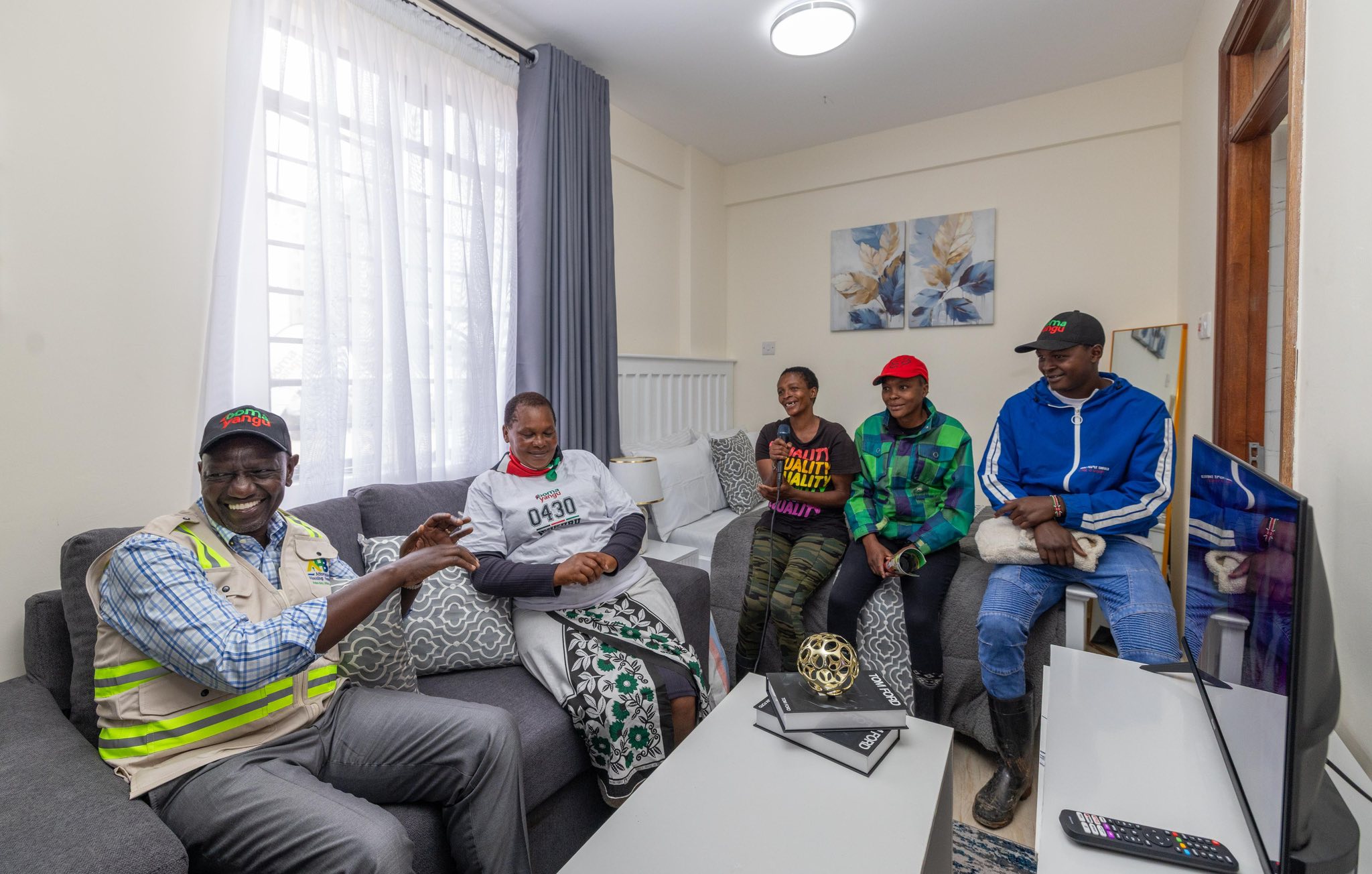
Fact about Mukuru Kwa Njenga Affordable Housing project
Register via Boma Yangu or dial *832#
Chief hustler has eased the burden of care, conferred dignity and opportunity to fellow hustlers
In Summary
 President William Ruto having a moment with new homeowners at the New Mukuru Housing Estate in Nairobi on May 20, 2025./PCS
President William Ruto having a moment with new homeowners at the New Mukuru Housing Estate in Nairobi on May 20, 2025./PCS
The last general election was an interesting one in that; it was framed as a contest between fixing the economy versus having a constitutional moment. The proponents for the constitutional moment argued that we needed more reforms especially about the architecture of governance, citing what they termed as electoral justice.
On the other hand, the proponents of fixing the economy argued that what bedeviled the country was lack of equal economic opportunities for the majority poor at the bottom of the pyramid.
Then Deputy President Wiliam Ruto coined the Hustler Nation narrative that sought to unite the hoi polloi (hustlers) against the bourgeoisie (dynasties), in what came to be referred to as the contest between ‘Bottom Up’ versus trickle down’ economics; it worked!
Ruto went ahead to be elected the fifth President of Kenya, symbolising the Bottom-Up story; having been a chicken seller, rising to become MP, assistant minister, minister, opposition leader, Deputy President and eventually the fifth President. It’s interesting to note that the UDA party’s symbol for this mass movement is a wheelbarrow; symbolising hard work and resilience to help rebuild our nation.
The Hustler Narrative was encapsulated into five pillars of the Beta Plan, which in a way is an actualisation of the Big 4 Agenda of the fourth administration that focused on manufacturing, food security, universal healthcare and affordable housing.
Three of the five pillars of the Beta Plan stem from the Big 4, albeit with a different approach and strategy.
The question that many will ask is whether President Ruto has kept to his promise of walking the talk of the Bottom-Up mantra.
The answer is a resounding YES. The narrative culminated into a manifesto that has put the hustler at the front and centre of government attention.
On Tuesday, Kenya witnessed a historic moment never seen before, when the President launched the biggest mini city to have ever been built in two-and-a-half years.
Mukuru New Estate, a 56 acre parcel of land has been transformed through the building of 13,248 homes, translating to over 66,240 potential residents, once completed.
The new homeowners, who were living in shacks, can now take a lift up to the 11th floor of their new studio apartment, not figuratively, but moving from the bottom up!
The heartwarming stories of Kenyans whose lives have been dignified is phenomenal. The country is witnessing a boom in construction in nearly all the 47 counties through affordable housing.
It’s not just about the heretofore impossible dream of owning a social house at only 3,900 per month – it’s the fact that these are homes, complete with clean water, piped gas for as low as Sh10, high speed Wi-Fi (for Sh10 per day), reliable electricity rather than illegal connections, fire extinguishing equipment, well lit areas, a primary and JSS school, a swimming pool and a clubhouse – amongst many other benefits.
The last such project was Buruburu Estate that has 5,000 houses, built over 15 years. New Mukuru has taken two-and-a-half years to be completed.
Pleasantly, for every Sh1 pumped in, Sh 2.50 has been gotten, having a multiplier effect of 250 times. The ripple effect in the private sector is amazing.
Due to the affordable housing programme, mortgage rates have reduced by 6.7 per cent over the last two years. It’s also true to say that the women who are now engaged in the construction industry have increased significantly towards the 30 per cent target as set by the President.
In addition, the private sector has benefited significantly from the supply of materials such as cement, steel, stones and wood, among others.
Kenya is officially a construction site and in many little towns spread across the length and breadth of our great country, the most significant infrastructure or installation is likely to be a market or affordable housing project put up under this pillar of the Beta Plan.
The same can be said of the Taifa Care, popularly known as SHA. The thinking before was that it wouldn’t work owing to the inefficiencies of the now defunct NHIF, which wound up with pending bills of close to Sh40 billion—a huge chunk of which are unverifiable.
Under SHA, the government is now clearing bills on the 14th of every month, with over Sh20 billion already disbursed to various hospitals. In fact, public hospitals are benefiting more than before.
The shift from the privatisation of healthcare to the revitalisation of public facilities has led to many hustlers being able to access Medicare for as low as Sh300 a month.
In fact, a video making rounds on social media has George Okwe, a young painter from Dandora, narrating how he recently got injured while hustling and how the public medical insurance paid the whole bill of Sh12,500.
When his wife delivered a bouncing baby boy, he wasn't able to go climb walls as he was in crutches, SHIF paid Sh15,000 for maternity fee. He only parted with Sh200.
Okwe’s story is replicated across the country, amongst the over 8.5 million Kenyans who have visited various facilities for treatment. Ramania (not her real name), lost her sister Phelisia (not her real name) and SHA paid the terminal costs of over Sh600,000!
This is just a tip of the iceberg of how the chief hustler has eased the burden of care, conferred dignity and opportunity to his fellow hustlers.

Register via Boma Yangu or dial *832#
